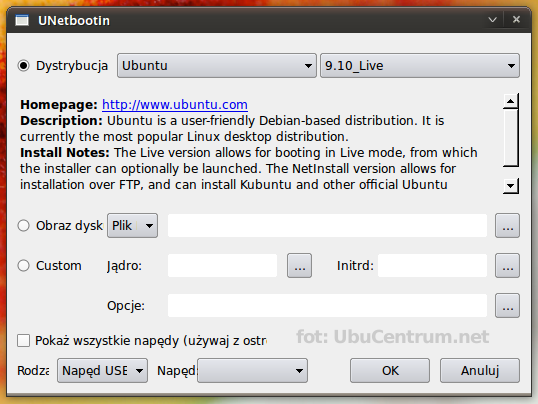


If the USB stick boots straight into the GUI and only then offers the option of ‘trying’ or ‘installing’ then that was a legacy BIOS boot. In case both boot methods are enabled in the BIOS, how can one tell which one is used? In the case of an Ubuntu 18.04 USB stick it can be easily told: If there is a text based screen from which ‘try Ubuntu’ or ‘install Ubuntu’ can be selected, UEFI is at work. This tool installs both a legacy and an UEFI boot configuration on the stick so it will work with both methods. Ah! Fortunately, there is a second tool in Ubuntu, the ‘Startup Disk Creator’. BUT, and that’s the big BUT, the resulting USB stick can only be booted with UEFI. The tool I usually use to copy an ISO boot image to a USB stick and make it bootable is UNetbootin.
#Unetbootin ubuntu 16.04 install#
Now that is strange, I thought, could it be that Ubuntu 18.04 now requires UEFI for booting and is no longer compatible with the legacy BIOS boot mode? Many retries later I figured out that it was not Ubuntu’s fault at all, but that the utility that I used to install the ISO boot image on the USB stick in the first place produced a boot stick that could only be used with an UEFI. So despite ‘legacy’ being preferred the OS installer on the stick always booted in UEFI mode. When I set the BIOS to legacy only, the USB stick also wouldn’t work. The Thing With The Boot Disk Creation ToolĪfter a lot of experimenting I found out that the other notebook’s BIOS was set to boot via UEFI and legacy, with legacy being tried first. But why couldn’t I create an installation with an MBR instead of an EFI partition? Doing a default installation or manually creating an EFI partition before the system partition on the other hand always produced a bootable installation. But even on the other notebook, I could not install an image that could be booted by the legacy BIOS, the installer always terminated with a non-descriptive error message. The thing that was really strange was that the USB boot stick pretended to work fine in another notebook while completely refusing to work in this 10 year old notebook I wanted to upgrade. After a lot of experimenting I found out why. But unfortunately, my Ubuntu 18.04 USB installation stick still wouldn’t boot. It took me a while to figure this one out and the obvious solution then was to switch-off UEFI in the BIOS and boot with the ‘legacy’ BIOS boot loader that requires GRUB to be put on the MBR (Master Boot Record). When I recently wanted to install Ubuntu 18.04 on a 10 year old notebook I was faced with a BIOS that had an early implementation of UEFI that just didn’t play along very nicely with today’s EFI bootloaders. Now even that is not possible.Some things should be easy but they are not. however, my laptop does not have the standard cable socket.
#Unetbootin ubuntu 16.04 update#
I am trying to do a BIOS update but that needs cable connection. I know this because I see the same screen in the boot menu, when either the usb is inserted, or not. I am using an HP laptop, and I have made sure I selected 'legacy support enabled and secureboot disabled', but the boot menu cannot find the usb.
#Unetbootin ubuntu 16.04 how to#
Ok so this seems to be a bios problem but i dont know how to configure it properly. Please install an operating system on your hard diskįor more information please visit What could be the problem and what should I do? I am sure i selected the usb device, but the booting process says Boot Device not found When tested on one laptop, it boots to the Unetbootin menu. I used Unetbootin to create an ubuntu18.04 image.


 0 kommentar(er)
0 kommentar(er)
